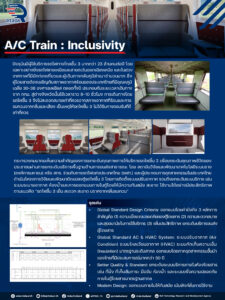Potentials and Constraints along the Thailand-Laos Freight Transport Corridor
Assessment of Potentials and Constraints along the Thailand-Laos Freight Transport Corridor
The Tha Na Laeng Land Pier serves as a crucial transfer point for goods adjacent to Thanaleng Station, which operates along the Nong Khai-Vientiane railway route. Situated in Ban Dong Phosy, Hadxayfong district, Vientiane Prefecture, Laos, the station is approximately 3.50 kilometers away from the initial Thai-Laos Friendship Bridge. The Vientiane Logistics Park Company Co., Ltd has been granted a concession to develop the Na Laeng land port, including the Vientiane Capital Logistics District, covering an expansive area of 2,387.5 rai (3.82 square kilometer). This development aims to establish an international checkpoint to facilitate customs procedures in the Lao PDR.
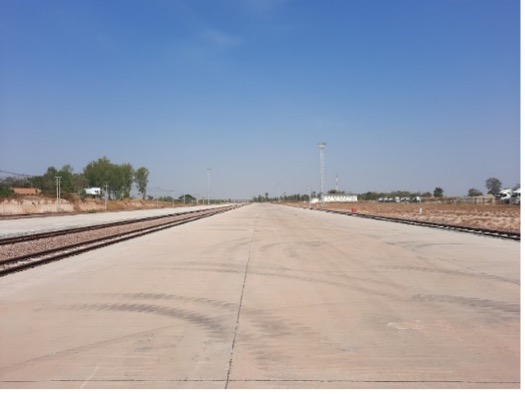
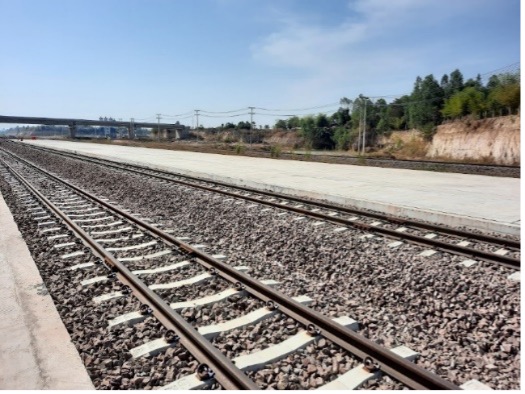
Loading and Unloading Yard (Transshipment Yard) comprises both Meter Gauge and Standard Gauge
Strength
- Thana Laeng Land Pier and Vientiane Capital Logistics Zone was built to be a transportation hub to facilitate both import and export activities in Lao PDR. It is equipped with product inspection and tax collection stations and serves as a pivotal location for goods transfer and exchange.
- It functions as an important rail freight connection point between Thailand, Laos, and China as it provides a designated area for transferring goods between the 1-meter (Meter Gauge) and 1.435-meter (Standard Gauge) rail systems.
- Goods imported from China that transit through Laos to Thailand and other countries, undergo sorting procedures at the Na Laeng land port before being further distributed or exported.
Weakness
- High-speed trains originating from China are presently unable to transfer goods at the Na Laeng land port due to regulatory constraints imposed by the Ministry of Public Works and Transport in Lao PDR. Consequently, freight transportation between the Thanaleng Land Port and Vientiane Southern Station is facilitated primarily through truck transportation.
- The transshipment of containers incurs considerable costs, largely attributed to the taxation framework implemented by the Lao PDR. This taxation mechanism significantly impacts the operators involved in transporting goods along this route.
Vientiane Station (Ban Khamsawad)
The Thai-Laos Railway Construction Project Phase-2 (Part-2) has received loan support (70% of the total budget) from the Thai government. It is the final station along the Nong Khai-Vientiane Railway Line. There is an extension from the station that spans approximately 7.5 kilometers across a dry rice field, utilizing a path size equivalent to 1 meter.
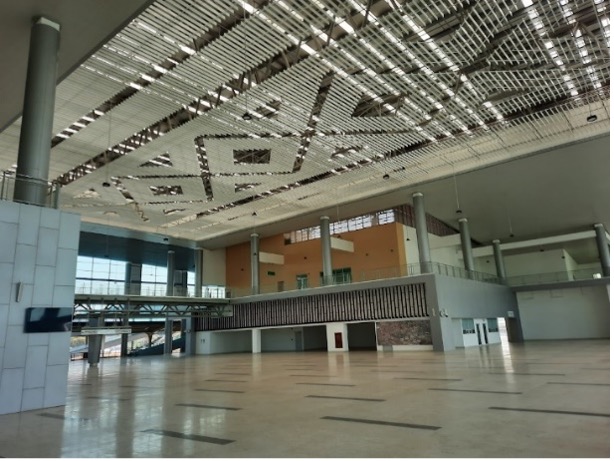
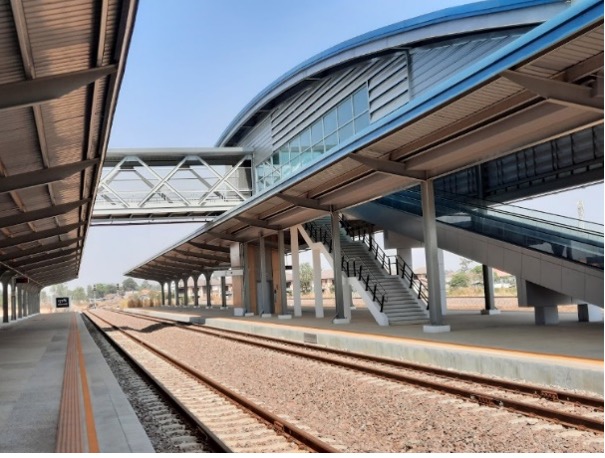
Vientiane Capital Railway Station Platform (Ban Khamsavat)
Strength
- The station provides only passenger transportation services. For container transportation, the shipping and transshipment operations are conducted at the Thanaleng Land Port. Bus services are provided in Laos, necessitating a driver change from Thai to Laos personnel. This arrangement is in accordance with the agreement governing the Thai-Laos train route, which stipulates that Thai employees are protected only up to Thanaleng station.
Weakness
- Passengers connecting to the China-Laos high-speed railway station need shuttle bus services, as there is currently no direct rail system connection available.
- The station is not operational yet as it awaits the readiness of high-speed trains from China, training sessions on vehicle operations and driving for railway officials of the Lao PDR.
Nong-Khai Station
Nong Khai station serves as the final stop in Thailand before connecting to Tha Na Laeng Station in the Lao PDR. Immigration officers are stationed at Nong Khai to serve passengers travelling to and from Thailand. Currently, several trains are operating between Nong Khai and Tha Na Laeng, with a total of four trains making round trips each day, with Customs officers providing inspection and release services for export and cross-border goods. Transporting goods through temperature-controlled containers requires submitting the container drawings to engineers for initial verification of whether the containers to be used can be used to carry goods according to SRT regulations or not, thereby mitigating the risk of delivery issues.
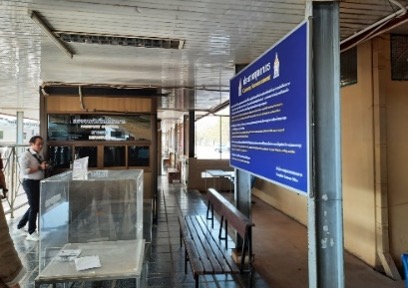
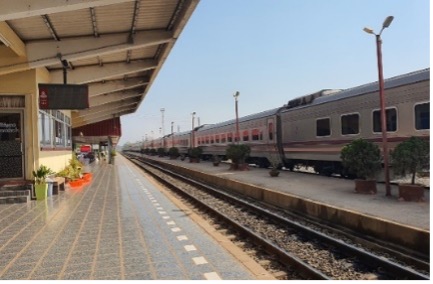
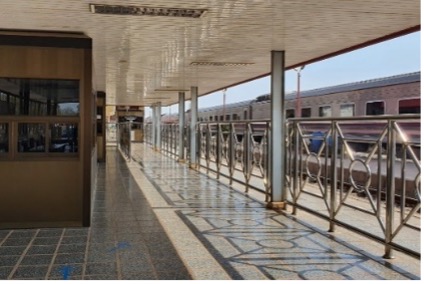
The area around Nong Khai Station
Strength
- One-stop service for passengers who seek to cross the border between Thailand and Lao PDR, with the assistance of immigration officers at Nong Khai Station through the timing of their bus trips.
Weakness
- The size limitations of Thai railway tracks are smaller compared to those connecting to trains originating from China. Consequently, exports of goods from Thailand to China necessitate transshipment for further transport to China at the Na Laeng land port in the Lao PDR. This process incurs additional costs and expenses. Moreover, passing through the Pasi checkpoint of the Lao PDR and the waiting time for inspecting goods at the checkpoint can impact the market price at the shipping destination.
- The bus route of Nong Khai-Tha Na Laeng-Nong Khai has a relatively low volume of passengers crossing the border via the rail system. However, in anticipation of potential future increases in passenger volume or demand for rail system usage, it is planned to increase bus operations to 7 times per day. It's important to note that this increase in bus operations may impact traffic density around the bridge, as the bridge needs to be closed to vehicular traffic every time a train passes through.
Natha Station
The station is planned for development into a Container Yard, Transshipment Yard and Depot, once the construction of the new Thai-Laos bridge is completed. There is a plan to construct a 1.435-meter road to connect the China-Laos high-speed train to Natha Sation, as well as a separate 1-meter road on the same bridge.
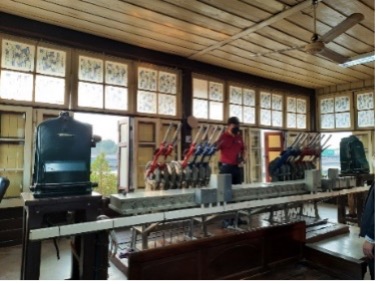
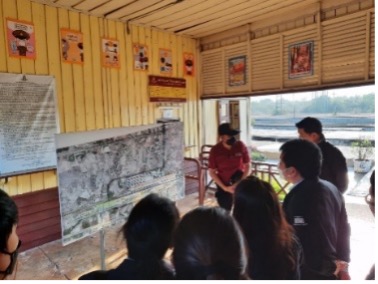
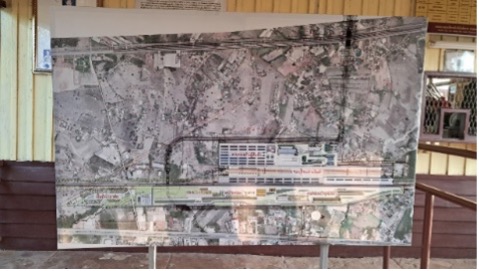
The area around Natha Station
Strength
- There will be a cargo transfer center that increases efficiency and ability to transfer from 1-meter to 1.435-meter rails and reduces the burden on export operators. This infrastructure will result in Thailand having the potential to compete better in foreign markets.
Weakness
- The construction schedule for the 2nd Nong Khai Friendship Bridge remains unclear, consequently impacting the development timeline for Natha Station.
- Plans to increase capacity in the future to support the transportation of agricultural products. The container yard will have supporting facilities such as charging points for temperature-controlled containers (Reefers) for temperature-controlled shipping, etc.
- Limitations on the size of the Subdistrict Municipality vehicles used for temperature-controlled shipping, which can only accommodate a 40-foot reefer container due to the protrusion of the clip-on part at the back of the cabinet. Conversely, the reefer cabinets on sub-district buses in China are larger. Therefore, measures need to be explored to support such transportation in the future.
Udon Thani Industrial Estate
The Udon Thani Industrial Estate, located in the Northeast Economic Corridor (NeEC) area within the industrial estate, is poised to develop into an area for packing and sorting stations, ICD boxes, a CY container yard, and a Free Zone which is envisioned to serve as a central region (Logistics Hub) in the future.
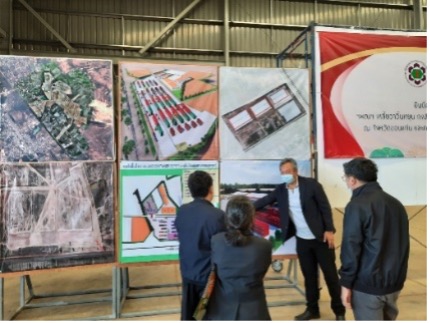
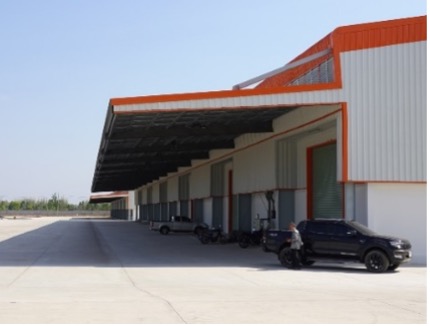
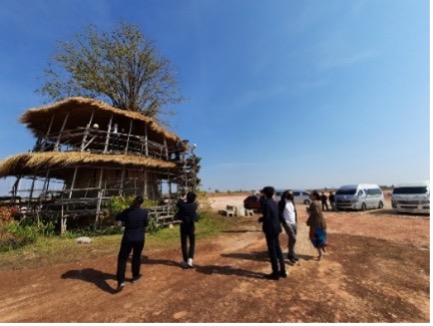
Area surrounding the Industrial City of Udon Thani
Strength
- The plan involves developing rail system connections from Nong Takai Station into the ICD area within the Udon Thani Industrial Estate. This initiative aims to streamline import-export operations for entrepreneurs efficiently.
- The location is along both the double-track railway line and the high-speed railway line, which serves as a strategic point for connectivity with neighboring countries (CLMV), positively impacts product distribution in the upper Isaan region, leading to cost reductions and increased competitive advantages for Thai entrepreneurs in the export market.
- ICD is designed to operate as a One-Stop service point, where customs officials conduct inspections of goods. Additionally, facilities are in place to provide charging services for temperature-controlled cabinets while awaiting inspection.
Weakness
- The number of rail freight trips is relatively small whilst the demand for sugar products reaches up to 10,000 trips per day and preparations are underway to combine bulk products for transportation by rail.
- Concerns of operators regarding potential restrictions on the number of train frequencies at Nong Takai Station, particularly in light of future transportation needs. The Industrial Estate suggested adding extra train trips to facilitate the pickup and delivery of products within the industrial estate, thus enhancing transportation efficiency.
- The fruit quarantine station takes time to check in many steps which led to product damage, increased costs for SMEs, and affected sales prices sent to China. As a solution, the operators encourage the assignment of fruit inspectors at industrial estates to reduce inspection time. Additionally, they suggest providing cold room services for storage purposes.
List of Authors
1) Mrs. Yaowalak Sunthornnon, Advisor
2) Ms. Phattharasuda Wichayapong, Senior Researcher
3) Miss Uma Phongkitdechhot, Researcher
4) Mrs. Nichapat Blake, Researcher
5) Mr. Teerapat Phukerd, Researcher
6) Mr. Kiattiphum Noisuwan, Researcher
7) Ms. Pimchanok Panthai, Analyst
8) Miss Phakwan Poonjitborisut, Technologist


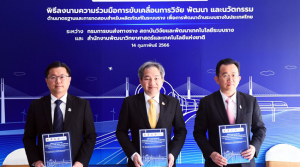
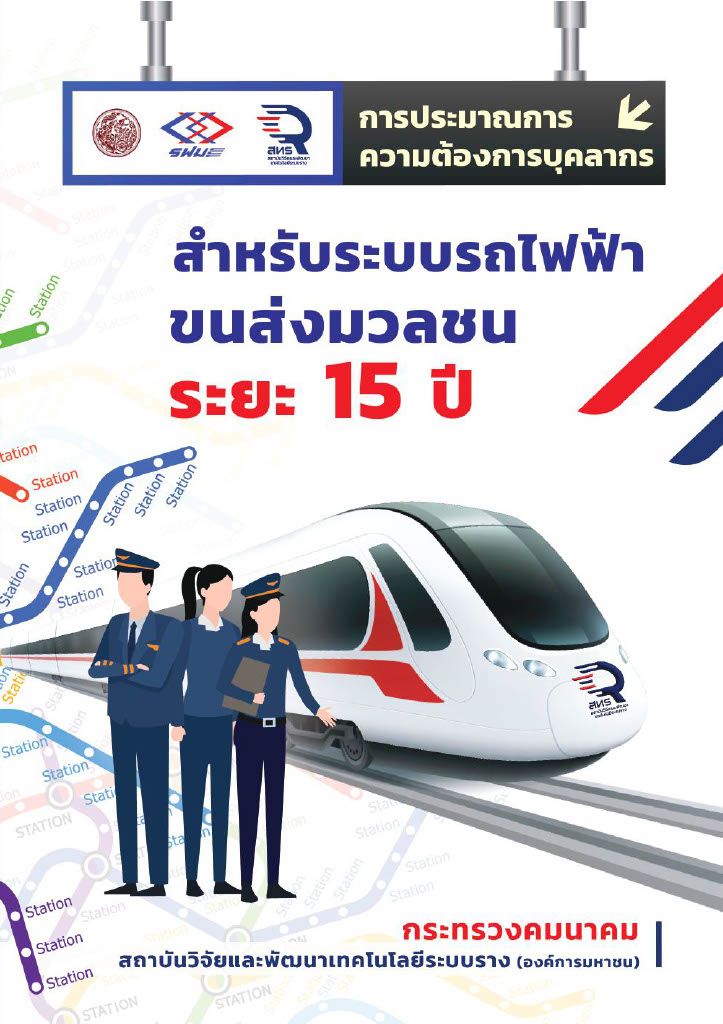 การประมาณการความต้องการบุคลากรสำหรับระบบรถไฟฟ้าขนส่งมวลชนระยะ 15 ปี ประเทศไทยได้กำหนดนโยบายการพัฒนาขีดความสามารถในการแข่งขันของประเทศ ซึ่งมีโครงสร้างพื้นฐานด้านคมนาคมและระบบโลจิสติกส์เป็นส่วนหนึ่งของฐานในการขับเคลื่อนการพัฒนา โดยเฉพาะระบบการขนส่งทางรางทั้งในด้านการขนส่งสินค้าและการขนส่งผู้โดยสาร และได้นำไปสู่การวางแผนขยายเส้นทางของระบบรางของประเทศ ทั้งในระบบการขนส่งทางไกล ซึ่งเป็นระบบโครงข่ายที่กระจายอยู่ทั่วประเทศ และระบบขนส่งรถไฟฟ้าในเมืองและรถไฟฟ้าระหว่างเมือง โดยเฉพาะอย่างยิ่งระบบไฟฟ้าขนส่งมวลชนในเมือง เนื่องด้วยประเทศไทยกำลังดำเนินการพัฒนาระบบขนส่งมวลชนทางรางประเภทรถไฟฟ้า และในบางเส้นทางนั้นมีแนวโน้มที่กำลังจะเปิดให้บริการในระยะเวลาอันใกล้สทร. ในฐานะหน่วยงานที่มีพันธกิจตามกฎหมายในการดำเนินการส่งเสริมและสนับสนุนการพัฒนาบุคลากรระบบรางของประเทศ จึงได้ดำเนินการศึกษาและพัฒนาการประมาณการความต้องการบุคลากรสำหรับระบบรถไฟฟ้าขนส่งมวลชน ระยะ 15 ปี เพื่อส่งเสริมการผลิตและพัฒนาบุคลากรระบบรางในประเทศ รวมถึงเพื่อเป็นกรอบแนวทางในการขับเคลื่อนการผลิตและพัฒนาบุคลากรระบบรางให้กับภาคผู้กำหนดนโยบาย ภาคผู้เดินรถ/ผู้ประกอบการ และภาคการศึกษาและฝึกอบรม รวมถึงประชาชนทั่วไปที่สนใจด้วย จากการศึกษาและรวบรวมข้อมูลแนวปฏิบัติทั้งในประเทศ และต่างประเทศ พบว่า กลุ่มงานและตำแหน่งงานที่เป็นส่วนหลักพื้นฐานในการบริหารจัดการเดินรถหนึ่งเส้นทางที่สำคัญ คือ ฝ่ายงานบริหารจัดการเดินรถ ซึ่งเป็นกลุ่มงานที่ต้องมีความรู้และประสบการณ์ด้านความปลอดภัยและด้านเทคนิค เพื่อให้สามารถบริการได้อย่างมีมาตรฐาน สะดวกสบาย ตรงต่อเวลา และปลอดภัยแก่ผู้รับบริการ รายงานการศึกษานี้ จึงมุ่งเน้นศึกษาและประมาณการความต้องการบุคลากรในฝ่ายงานบริหารจัดการเดินรถเป็นสำคัญ ซึ่งประกอบด้วย 3 กลุ่มงานหลัก ได้แก่
การประมาณการความต้องการบุคลากรสำหรับระบบรถไฟฟ้าขนส่งมวลชนระยะ 15 ปี ประเทศไทยได้กำหนดนโยบายการพัฒนาขีดความสามารถในการแข่งขันของประเทศ ซึ่งมีโครงสร้างพื้นฐานด้านคมนาคมและระบบโลจิสติกส์เป็นส่วนหนึ่งของฐานในการขับเคลื่อนการพัฒนา โดยเฉพาะระบบการขนส่งทางรางทั้งในด้านการขนส่งสินค้าและการขนส่งผู้โดยสาร และได้นำไปสู่การวางแผนขยายเส้นทางของระบบรางของประเทศ ทั้งในระบบการขนส่งทางไกล ซึ่งเป็นระบบโครงข่ายที่กระจายอยู่ทั่วประเทศ และระบบขนส่งรถไฟฟ้าในเมืองและรถไฟฟ้าระหว่างเมือง โดยเฉพาะอย่างยิ่งระบบไฟฟ้าขนส่งมวลชนในเมือง เนื่องด้วยประเทศไทยกำลังดำเนินการพัฒนาระบบขนส่งมวลชนทางรางประเภทรถไฟฟ้า และในบางเส้นทางนั้นมีแนวโน้มที่กำลังจะเปิดให้บริการในระยะเวลาอันใกล้สทร. ในฐานะหน่วยงานที่มีพันธกิจตามกฎหมายในการดำเนินการส่งเสริมและสนับสนุนการพัฒนาบุคลากรระบบรางของประเทศ จึงได้ดำเนินการศึกษาและพัฒนาการประมาณการความต้องการบุคลากรสำหรับระบบรถไฟฟ้าขนส่งมวลชน ระยะ 15 ปี เพื่อส่งเสริมการผลิตและพัฒนาบุคลากรระบบรางในประเทศ รวมถึงเพื่อเป็นกรอบแนวทางในการขับเคลื่อนการผลิตและพัฒนาบุคลากรระบบรางให้กับภาคผู้กำหนดนโยบาย ภาคผู้เดินรถ/ผู้ประกอบการ และภาคการศึกษาและฝึกอบรม รวมถึงประชาชนทั่วไปที่สนใจด้วย จากการศึกษาและรวบรวมข้อมูลแนวปฏิบัติทั้งในประเทศ และต่างประเทศ พบว่า กลุ่มงานและตำแหน่งงานที่เป็นส่วนหลักพื้นฐานในการบริหารจัดการเดินรถหนึ่งเส้นทางที่สำคัญ คือ ฝ่ายงานบริหารจัดการเดินรถ ซึ่งเป็นกลุ่มงานที่ต้องมีความรู้และประสบการณ์ด้านความปลอดภัยและด้านเทคนิค เพื่อให้สามารถบริการได้อย่างมีมาตรฐาน สะดวกสบาย ตรงต่อเวลา และปลอดภัยแก่ผู้รับบริการ รายงานการศึกษานี้ จึงมุ่งเน้นศึกษาและประมาณการความต้องการบุคลากรในฝ่ายงานบริหารจัดการเดินรถเป็นสำคัญ ซึ่งประกอบด้วย 3 กลุ่มงานหลัก ได้แก่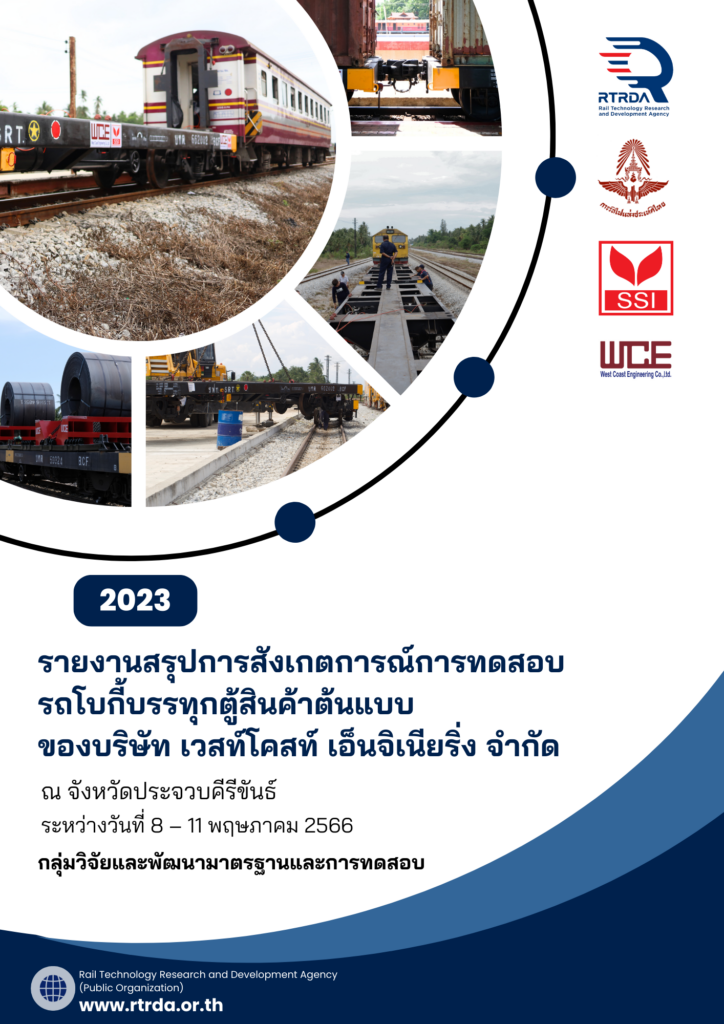 ด้วยกลุ่มงานวิจัยและพัฒนามาตรฐานและการทดสอบ สถาบันวิจัยและพัฒนาเทคโนโลยีระบบราง (องค์การมหาชน) (สทร..) มีพันธกิจในการพัฒนามาตรฐานระบบการทดสอบและดำเนินการทดสอบด้านระบบราง ซึ่งทาง บริษัท เวสท์โคสท์ เอ็นจิเนียริ่ง จำกัด (WCE) บริษัทในเครือสหวิริยาสตีลอินดัสตรี จำกัด (SSI) ได้เป็นพันธมิตรและทำบันทึกตกลงความร่วมมือ (MOU) ระหว่าง สทร. กับ WCE เรื่อง การส่งเสริมสนับสนุนการยกระดับขีดความสามารถในการแข่งขันของอุตสาหกรรมระบบรางของประเทศ” โดยทาง WCE ได้เชิญให้ สทร. เข้าร่วมสังเกตการณ์การทดสอบ Static Test และ Running Test ของรถโบกี้บรรทุกตู้สินค้า (บทต ตามมาตรฐานวิธีการทดสอบการรถไฟแห่งประเทศไทย โดยดำเนินการระหว่างวันที่ 8 11 พฤษภาคม 2566 ณ บริษัท เวสโคสท์ เอ็นจิเนียริ่ง จำกัด และสถานีรถไฟนาผักขวง จังหวัดประจวบคีรีขันธ์
ด้วยกลุ่มงานวิจัยและพัฒนามาตรฐานและการทดสอบ สถาบันวิจัยและพัฒนาเทคโนโลยีระบบราง (องค์การมหาชน) (สทร..) มีพันธกิจในการพัฒนามาตรฐานระบบการทดสอบและดำเนินการทดสอบด้านระบบราง ซึ่งทาง บริษัท เวสท์โคสท์ เอ็นจิเนียริ่ง จำกัด (WCE) บริษัทในเครือสหวิริยาสตีลอินดัสตรี จำกัด (SSI) ได้เป็นพันธมิตรและทำบันทึกตกลงความร่วมมือ (MOU) ระหว่าง สทร. กับ WCE เรื่อง การส่งเสริมสนับสนุนการยกระดับขีดความสามารถในการแข่งขันของอุตสาหกรรมระบบรางของประเทศ” โดยทาง WCE ได้เชิญให้ สทร. เข้าร่วมสังเกตการณ์การทดสอบ Static Test และ Running Test ของรถโบกี้บรรทุกตู้สินค้า (บทต ตามมาตรฐานวิธีการทดสอบการรถไฟแห่งประเทศไทย โดยดำเนินการระหว่างวันที่ 8 11 พฤษภาคม 2566 ณ บริษัท เวสโคสท์ เอ็นจิเนียริ่ง จำกัด และสถานีรถไฟนาผักขวง จังหวัดประจวบคีรีขันธ์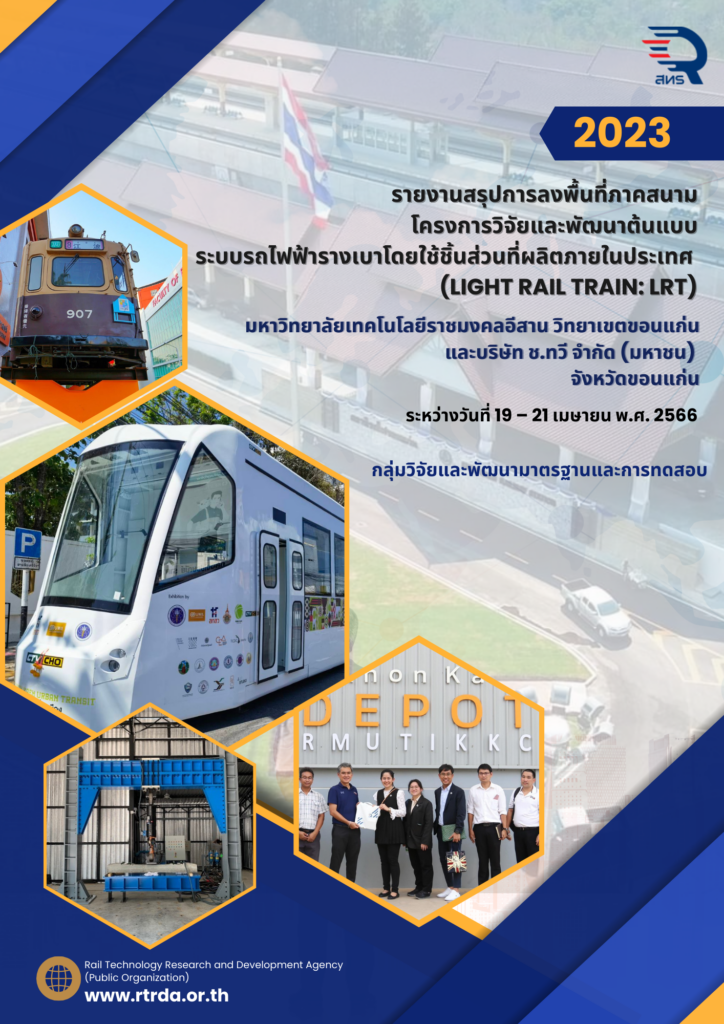 เอกสารฉบับนี้ จัดทาขึ้น เพื่อศึกษาแนวทางการผลักดันและส่งเสริมการผลิตชิ้นส่วนอะไหล่และผลิตภัณฑ์ด้านอุตสาหกรรมการขนส่งทางรางให้เกิดขึ้นในประเทศ ตามการพัฒนาห่วงโซ่อุปทาน (Supply Chain) เพื่อให้เกิด Local Content ที่ยั่งยืน สอดคล้องกับแผนยุทธศาสตร์ชาติ 20 ปี ควบคู่กับแผนยุทธศาสตร์คมนาคม ซึ่งทาง สทร. ได้เล็งเห็นความสาคัญการสนับสนุนการสร้างอุตสาหกรรมการผลิตชิ้นส่วนระบบรางในประเทศ เพื่อสนับสนุนนโยบาย Thai First ผ่านแผนงานบูรณาการความร่วมมือ เพื่อยกระดับคุณภาพบริการและการผลิตให้เทียบเท่ามาตรฐานสากล
เอกสารฉบับนี้ จัดทาขึ้น เพื่อศึกษาแนวทางการผลักดันและส่งเสริมการผลิตชิ้นส่วนอะไหล่และผลิตภัณฑ์ด้านอุตสาหกรรมการขนส่งทางรางให้เกิดขึ้นในประเทศ ตามการพัฒนาห่วงโซ่อุปทาน (Supply Chain) เพื่อให้เกิด Local Content ที่ยั่งยืน สอดคล้องกับแผนยุทธศาสตร์ชาติ 20 ปี ควบคู่กับแผนยุทธศาสตร์คมนาคม ซึ่งทาง สทร. ได้เล็งเห็นความสาคัญการสนับสนุนการสร้างอุตสาหกรรมการผลิตชิ้นส่วนระบบรางในประเทศ เพื่อสนับสนุนนโยบาย Thai First ผ่านแผนงานบูรณาการความร่วมมือ เพื่อยกระดับคุณภาพบริการและการผลิตให้เทียบเท่ามาตรฐานสากล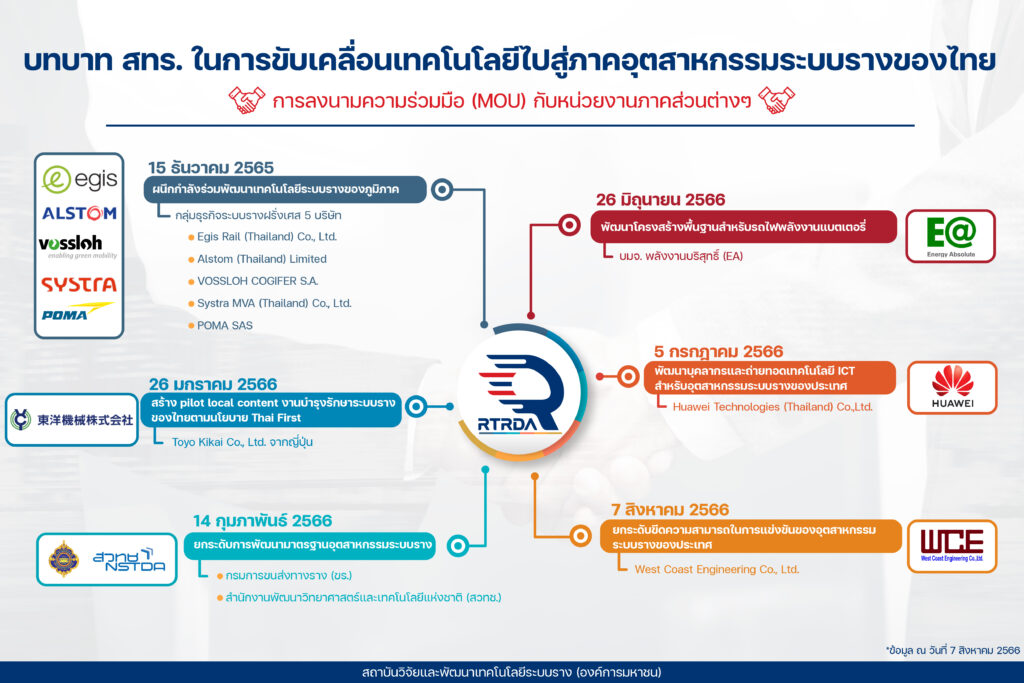
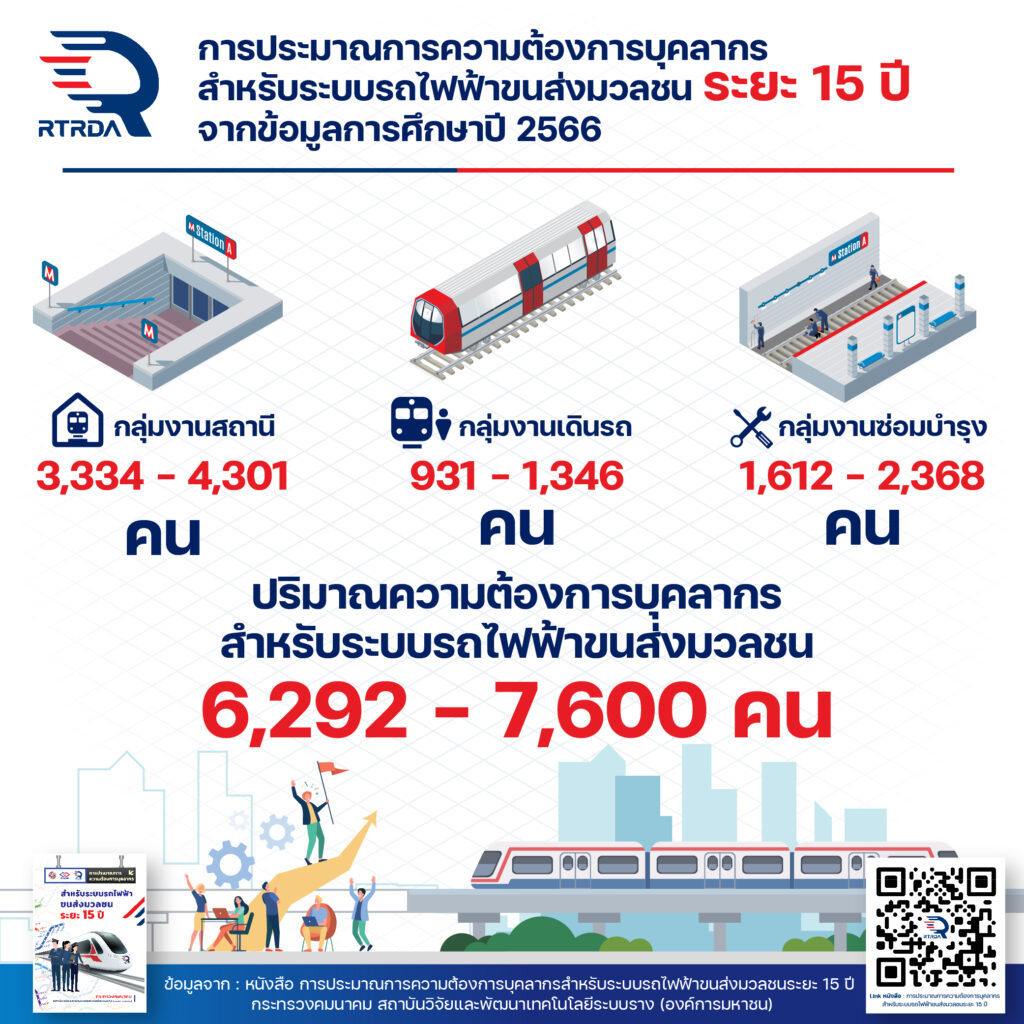
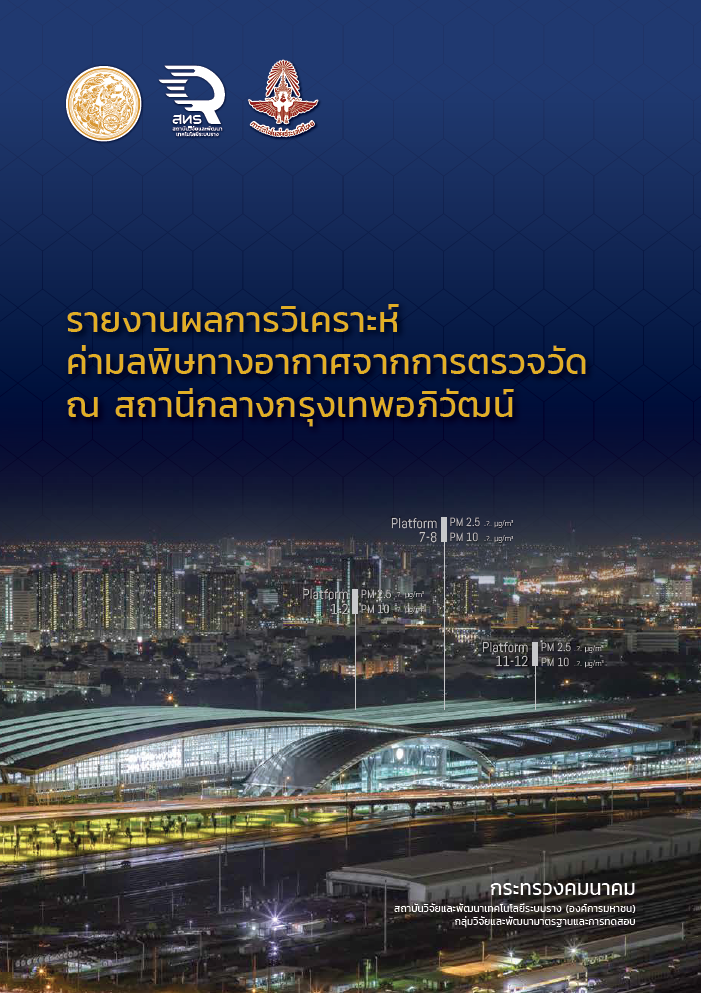 สถาบันวิจัยและพัฒนาเทคโนโลยีระบบราง (องค์การมหาชน) เล็งเห็นถึงความจำเป็นเร่งด่วน โดยได้ดำเนินการลงพื้นที่เพื่อทำการตรวจวัดค่ามลพิษทางอากาศ ณ บริเวณ ชานชาลา สถานีกลางกรุงเทพอภิวัฒน์ โดยใช้เทคนิควิธีการวัดและเครื่องมือที่ได้มาตรฐานสากล และมีระบบ คุณภาพเป็นไปตามมาตรฐาน ISO/IEC 17025 แต่อย่างไรก็ดี ผลการตรวจวัดดังกล่าว ไม่สามารถแปรผลและ ใช้งานได้ทันที จำเป็นต้องถูกวิเคราะห์อย่างละเอียด เพื่อให้สามารถแก้ปัญหาได้อย่างถูกต้องตรงประเด็น อัน จะช่วยให้การกำหนดแนวทางแก้ไขปัญหาสามารถดำเนินการได้อย่างเป็นรูปธรรม อีกทั้งยังช่วยลดค่าใช้จ่ายใน ดำเนินการปรับปรุง และป้องกันปัญหาดังกล่าวด้วย
สถาบันวิจัยและพัฒนาเทคโนโลยีระบบราง (องค์การมหาชน) เล็งเห็นถึงความจำเป็นเร่งด่วน โดยได้ดำเนินการลงพื้นที่เพื่อทำการตรวจวัดค่ามลพิษทางอากาศ ณ บริเวณ ชานชาลา สถานีกลางกรุงเทพอภิวัฒน์ โดยใช้เทคนิควิธีการวัดและเครื่องมือที่ได้มาตรฐานสากล และมีระบบ คุณภาพเป็นไปตามมาตรฐาน ISO/IEC 17025 แต่อย่างไรก็ดี ผลการตรวจวัดดังกล่าว ไม่สามารถแปรผลและ ใช้งานได้ทันที จำเป็นต้องถูกวิเคราะห์อย่างละเอียด เพื่อให้สามารถแก้ปัญหาได้อย่างถูกต้องตรงประเด็น อัน จะช่วยให้การกำหนดแนวทางแก้ไขปัญหาสามารถดำเนินการได้อย่างเป็นรูปธรรม อีกทั้งยังช่วยลดค่าใช้จ่ายใน ดำเนินการปรับปรุง และป้องกันปัญหาดังกล่าวด้วย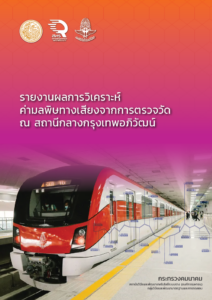 ทางสถาบันวิจัยและพัฒนาเทคโนโลยีระบบราง (องค์การมหาชน) เล็งเห็นถึงความจําเป็นเรื่องด่วนในการแก้ไขปัญหาที่เกิดขึ้น จึงได้เรื่องดําเนินการลงพื้นที่เพ่ือทําการตรวจวัดค่า มลพิษทางด้านเสียงรบกวน ณ บริเวณชานชาลา สถานีกลางกรุงเทพอภิวัฒน์ โดยใช้เทคนิควิธีการวัดและ เครื่องมือที่ได้มาตรฐานสากล และมีระบบคุณภาพเป็นไปตามมาตรฐาน ISO/IEC 17025 แต่อย่างไรก็ดี ผลการตรวจวัดดังกล่าว ไม่สามารถแปรผลและใช้งานได้ทันที จําเป็นต้องถูกวิเคราะห์อย่างละเอียด เพื่อให้ สามารถแก้ปัญหาได้อย่างถูกต้องตรงประเด็น อันจะช่วยให้การกําหนดแนวทางแก้ไขปัญหาสามารถดําเนินการ ได้อย่างเป็นรูปธรรม อีกทั้งยังช่วยลดค่าใช้จ่ายในดําเนินการปรับปรุง และป้องกันปัญหาดังกล่าวด้วย
ทางสถาบันวิจัยและพัฒนาเทคโนโลยีระบบราง (องค์การมหาชน) เล็งเห็นถึงความจําเป็นเรื่องด่วนในการแก้ไขปัญหาที่เกิดขึ้น จึงได้เรื่องดําเนินการลงพื้นที่เพ่ือทําการตรวจวัดค่า มลพิษทางด้านเสียงรบกวน ณ บริเวณชานชาลา สถานีกลางกรุงเทพอภิวัฒน์ โดยใช้เทคนิควิธีการวัดและ เครื่องมือที่ได้มาตรฐานสากล และมีระบบคุณภาพเป็นไปตามมาตรฐาน ISO/IEC 17025 แต่อย่างไรก็ดี ผลการตรวจวัดดังกล่าว ไม่สามารถแปรผลและใช้งานได้ทันที จําเป็นต้องถูกวิเคราะห์อย่างละเอียด เพื่อให้ สามารถแก้ปัญหาได้อย่างถูกต้องตรงประเด็น อันจะช่วยให้การกําหนดแนวทางแก้ไขปัญหาสามารถดําเนินการ ได้อย่างเป็นรูปธรรม อีกทั้งยังช่วยลดค่าใช้จ่ายในดําเนินการปรับปรุง และป้องกันปัญหาดังกล่าวด้วย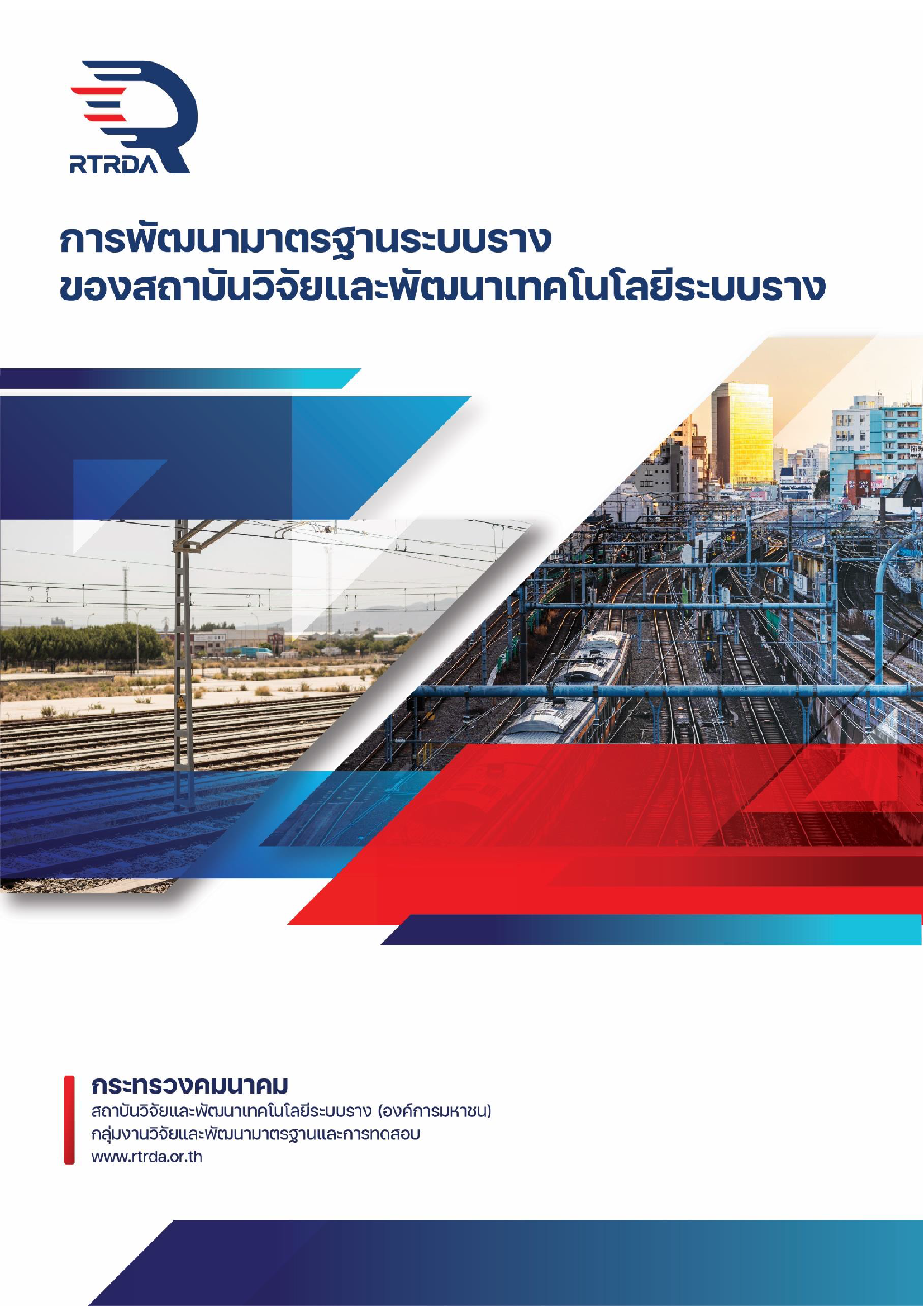 การดำเนินโครงการขนส่งทางรางด้านต่างๆ ไม่ว่าด้านออกแบบ การกำหนดคุณลักษณะเฉพาะของชิ้นส่วนอุปกรณ์ การติดตั้ง การทดสอบ การซ่อมบำรุง และการเดินรถ จำเป็นต้องปฏิบัติหรืออ้างอิงให้เป็นไปตามมาตรฐานระบบรางที่เป็นสากลหรือเป็นที่ยอมรับ แต่ปัจจุบัน พบว่า การกำหนดมาตรฐานระบบรางในประเทศไทยยังมีข้อจำกัด
การดำเนินโครงการขนส่งทางรางด้านต่างๆ ไม่ว่าด้านออกแบบ การกำหนดคุณลักษณะเฉพาะของชิ้นส่วนอุปกรณ์ การติดตั้ง การทดสอบ การซ่อมบำรุง และการเดินรถ จำเป็นต้องปฏิบัติหรืออ้างอิงให้เป็นไปตามมาตรฐานระบบรางที่เป็นสากลหรือเป็นที่ยอมรับ แต่ปัจจุบัน พบว่า การกำหนดมาตรฐานระบบรางในประเทศไทยยังมีข้อจำกัด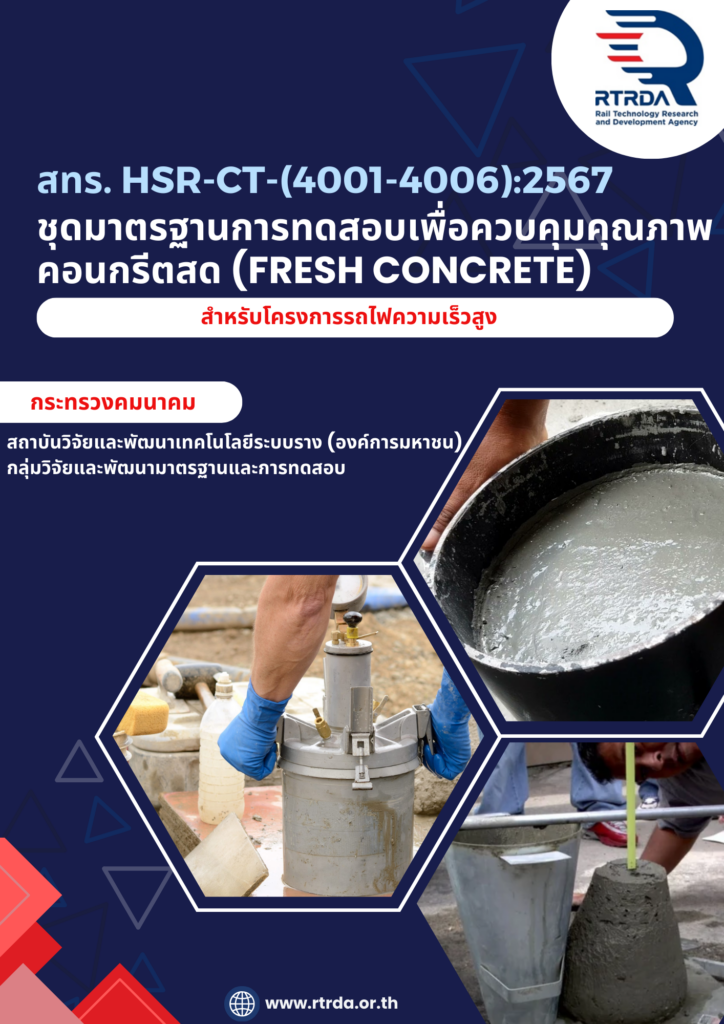 สทร. HSR-CT-(4001-4006):2567
สทร. HSR-CT-(4001-4006):2567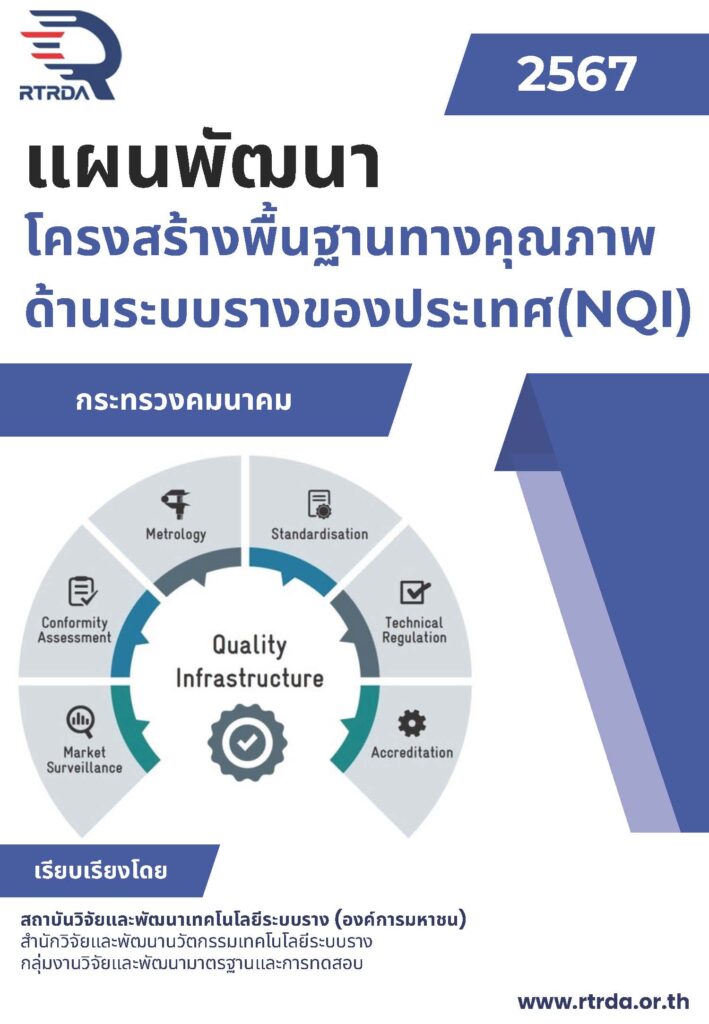 รายงานแผนพัฒนาโครงสร้างพื้นฐานทางคุณภาพด้านระบบรางของประเทศ(NQI)
รายงานแผนพัฒนาโครงสร้างพื้นฐานทางคุณภาพด้านระบบรางของประเทศ(NQI)